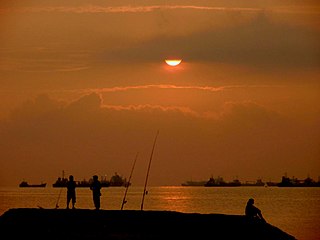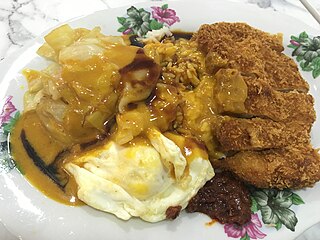
Punggol is a planning area and new town situated on the Tanjong Punggol peninsula in the North-East Region of Singapore. The town directly borders Sengkang to the south and shares riverine boundaries with the planning area of Seletar to the west and Pasir Ris to the east. Bounding the town to the north and north-east is the Straits of Johor, with Coney Island included as a part of the Punggol planning area.

Bak kut teh is a pork rib dish cooked in broth popularly served in Malaysia and Singapore where there is a predominant Hoklo and Teochew community.

East Coast Park is a beach and a park on the southeastern coast of Singapore. It stretches along the south of Marine Parade, Bedok and Tampines. It was opened in the 1970s, after the Singapore government had completed reclaiming land off the coast at Katong, from Kallang to Changi. Themed "Recreation for All", it not only serves the needs of communities in the east, other Singapore residents do also visit the park for sports, recreation, and food.

BreadTalk Group Private Limited is a Singaporean multinational snack and beverage corporation headquartered in Paya Lebar, Singapore.

Singaporean cuisine is derived from several ethnic groups in Singapore and has developed through centuries of political, economic, and social changes in the cosmopolitan city-state.

Chilli crab is a Southeast Asian seafood dish that is widely associated with the cuisines of both Malaysia and Singapore. The widely known version of chili crab today could be traced back to the 1950s in Malaysia and Singapore. Mud crabs are commonly used and are stir-fried in a semi-thick, sweet, and savoury tomato-and-chilli-based sauce.

Black pepper crab is one of the popular ways that crab is served in Singaporean cuisine. It is made by frying hard-shell crabs with black pepper. Unlike the other popular chilli crab dish, it is not cooked in a sauce and therefore has a dry consistency. It is becoming very popular to mix the pepper crab with a fresh jackfruit sauce.
The Long Beach Seafood Restaurant is a Singaporean restaurant chain best known for creating the original black pepper crabs. The main restaurant is located along the East Coast Parkway, with four other branches in Marina South, IMM Building, East Coast Seafood Centre and Dempsey Road at Tanglin.

Indian Singaporean cuisine refers to food and beverages produced and consumed in Singapore that are derived, wholly or in part, from South Asian culinary traditions. The great variety of Singapore food includes Indian food, which tends to be Tamil cuisine and especially local Tamil Muslim cuisine, although North Indian food has become more visible recently. Indian dishes have become modified to different degrees, after years of contact with other Singapore cultures, and in response to locally available ingredients as well as changing local tastes. The local forms of Indian food may be seen as localised or even regional variations of Indian food, or in some cases, a form of hybrid Indian-Singaporean cuisine. Popular 'Indian' dishes and elements of Indian cuisine include:
Paradise Group Holdings Pte Ltd is a Singapore-based restaurant group incorporated in 2002 by Eldwin Chua and Edlan Chua. The company's restaurants serve a variety of Chinese cuisine. Their brands include Seafood Paradise, Paradise Inn, Taste Paradise, Paradise Dynasty, KungFu Paradise, Paradise Pavilion, One Paradise and Canton Paradise. As of 2021, the company operates restaurants in its home country of Singapore, as well as in Malaysia, Indonesia, China, and the United States.
The SingTel Hawker Heroes Challenge was organised by SingTel and was held on 7 July 2013 at the Newton Food Centre. Live streaming of the challenge was broadcast by Singtel on its HungryGoWhere portal, as well as the announcement of results on Mio TV. The challenge involved popular television personality and UK chef, Gordon Ramsay, pitting his skills against a group of chosen food hawkers in Singapore.
Palm Beach Seafood Restaurant is a Singaporean restaurant that first began along Upper East Coast Road in Singapore, with its owners credited with inventing and developing the popular local dish, the Singaporean chili crab.

Char kway teow is a stir-fried rice noodle dish from Maritime Southeast Asia of southern Chinese origin. In Hokkien and Teochew, char means 'stir-fried' and kway teow refers to flat rice noodles. It is made from flat rice noodles or kway teow of approximately 1 cm or about 0.5 cm in width, stir-fried over very high heat with garlic, light and dark soy sauce, chili paste, whole prawns, shelled blood cockles, chopped Chinese chives, slices of Chinese sausage, and bean sprouts. Other common ingredients include fishcake and belachan.

Hainanese chicken rice is a dish of poached chicken and seasoned rice, served with chilli sauce and usually with cucumber garnishes. It was created by immigrants from Hainan in southern China and adapted from the Hainanese dishes of Wenchang chicken and Wenchang chicken rice.

Hainanese curry rice is a Singaporean dish consisting of steamed white rice smothered with curries and gravy, characteristically accompanied by curry chicken, pork chop, chap chye and kong bak. It originates in Singaporean cuisine and is not thought of as part of the cuisine of Hainan, China although it was created by Hainanese people.

Prima Taste, is a Singaporean food and beverage brand managed by Prima Food Pte Ltd, a wholly owned subsidiary of Prima Limited. The brand was designed for Singaporean expatriates living abroad. Its Laksa sauce kits were recommended by Singaporean chef, Janice Wong, as foodie souvenirs to take home during the 2018 North Korea–United States summit.
Sin Huat Eating House is a restaurant located in Geylang, Singapore. It is run by Danny Lee and primarily serves seafood dishes, including crab bee hoon.













